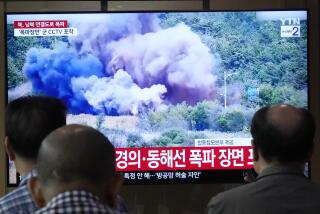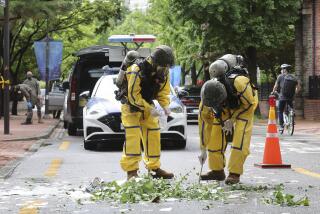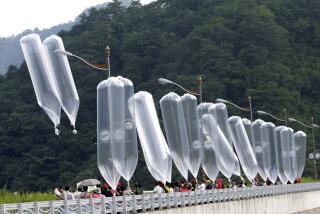In Defiance, North Korea Fires Missiles
SEOUL — Defying broad international pressure, North Korea test-fired at least six missiles into the Sea of Japan today, including a long-range Taepodong 2 that has been the focus of tension because of its purported ability to reach U.S. territory.
American officials said the long-range missile vanished about 40 seconds into its flight. South Korean media quoted senior defense officials who said it exploded when its fuel ignition system failed, with debris falling into waters off the coasts of Japan and Russia.
“The Taepodong was obviously a failure,” national security advisor Stephen Hadley said. “That tells you something about capabilities.”
The others, a mix of short-range Scud and mid-range Rodong ballistic missiles, also landed in the Sea of Japan. South Korean media reported that as many as 10 missiles may have been fired, but those reports could not be confirmed.
Hadley described the barrage of missiles, which started about the same time as the space shuttle Discovery’s Independence Day launch from Cape Canaveral, Fla., as “provocative behavior” from a country that had been warned against breaking its 6-year-old moratorium on long-range missile tests.
“The United States strongly condemns these missile launches and North Korea’s unwillingness to heed calls for restraint from the international community,” the White House said in a statement. It said the tests “demonstrate North Korea’s intent to intimidate other states by developing missiles of increasingly longer ranges.”
U.S. officials said Assistant Secretary of State Christopher Hill would travel to the region to consult with U.S. allies.
The missiles were launched over a period of about four hours. The Taepodong 2 was the third in the series, U.S. officials said.
The flurry of launches came despite repeated warnings from Washington and Tokyo of repercussions should North Korea test the multistage Taepodong 2.
North Korea claims to have nuclear weapons and is believed to have enough plutonium to build several of them, although the reclusive communist state is not thought to have the ability yet to mount them on missiles.
The U.S. military’s Northern Command said in a statement that it was able to detect the launches of all six missiles and quickly determined that they posed no threat to the United States.
The Bush administration consulted Tuesday with Asian governments and United Nations Security Council members on a coordinated response to the tests.
The Security Council will meet today at the request of Japan to discuss a resolution that will probably condemn the missile launches as a threat to international peace and security.
That could pave the way for future economic sanctions or even military action. But even sanctions are unlikely at this point because China, a permanent, veto-holding member of the Security Council, is likely to block punitive action. China has long held that the North Korean issue is best solved through behind-the-scenes diplomacy, and that public international condemnation might drive Pyongyang further into isolation.
North Korea has suspended six-party talks on its nuclear program that include the United States, China, South Korea, Japan and Russia.
Reports in June had suggested that North Korea was fueling the Taepodong 2 in preparation for a test.
Secretary of State Condoleezza Rice warned the regime that Washington would regard a test as a provocative act signaling rejection of international efforts to reach a compromise over North Korea’s nuclear weapons program.
In 1998, the North Koreans test-fired an earlier version of the same missile. It landed in the Pacific about 200 miles off the coast of Japan, traveling a total of 800 miles. Although the North signed a moratorium on test launches the following year, its engineers have been working since then to perfect the engine systems and guidance.
The range on their current missile was thought to be at least 2,400 miles, nearly enough to reach Guam, although some have raised the possibility that it could hit the continental United States, about 6,000 miles away.
North Korea also had technical difficulties with its 1998 launch when the third stage of the Taepodong 1 failed to get a satellite into orbit.
The multiple missile launches provoked a swift, sharp condemnation from Japan. Shinzo Abe, Japan’s most senior Cabinet official, called the tests “a grave problem in terms of peace and stability of the international community and proliferation of weapons of mass destruction.
“We strongly protest against North Korea,” Abe said.
South Korea, which had been trying to downplay the military significance of a North Korean long-range missile test in an attempt to ease the sense of crisis on the peninsula, could deliver the harshest punishment if it makes good on its threat to cut off its substantial humanitarian aid, including rice, to the North.
Suh Choo-suk, a national security aide to South Korea’s president, said the missile test was “an unwise act” that could have a “negative impact, including the worsening of public sentiment on North Korea.”
The Taepodong 2’s failure could prove a deep embarrassment to North Korea, which likes to boast with colorful propaganda that it can annihilate the United States. However, a failure might never be mentioned in North Korea, where the media are tightly controlled and access to the Internet and other outside sources of information is restricted to a privileged few. There was no immediate comment from Pyongyang.
The North Koreans to this day have never acknowledged the failure to put a satellite into orbit. They claim the satellite, which they call Kwangmyongsong, or Bright Star, is broadcasting from space the sayings of leader Kim Jong Il and “powerfully demonstrating the scientific and technological potential” of North Korea.
“It is certainly a setback for them after all the bluster and rhetoric out of Pyongyang,” said Daniel Pinkston of the Monterey, Calif.-based Center for Nonproliferation Studies.
The purpose of launching several missiles in sequence from more than one site was to test command-and-control systems, analysts say.
“It’s not unusual for them to do several tests at once,” said Joseph S. Bermudez Jr., a U.S.-based expert on the North Korean military. “That’s the way it is done for military exercises.”
Experts point out that missiles normally require dozens of tests to iron out problems before they become operational. “It takes a significant amount of testing to test the reliability of a system,” Pinkston said. “And they are nowhere near that.”
North Korea’s move was also a slap at China, its closest ally, which was in the midst of trying to convene an “informal” gathering of the six countries negotiating the issue of the North’s nuclear program.
North Korea has boycotted the negotiations since November, after Washington cracked down against firms and banks suspected of colluding in what the U.S. says are the regime’s illicit financial dealings. U.S. pressure led a Macao bank to freeze North Korean assets after the Bush administration alleged that at least some of the money came from state-sponsored money laundering and counterfeiting of U.S. dollars.
But North Korea says the restrictions violate Washington’s pledge to not show “hostile intent.” North Korea has said it will not resume talks until the bank releases the money.
Beijing wanted to convene the informal talks as a way for the North to return to the table without having to back away from its boycott or fire a missile to demonstrate its resolve.
But China is also operating with one eye on Washington and Tokyo. The North Korean nuclear program has provided justification for U.S.-Japanese plans to develop a system that could shoot down an incoming warhead.
*
Times staff writers James Gerstenzang, Paul Richter and Peter Spiegel in Washington and Maggie Farley at the United Nations contributed to this report.
*
(BEGIN TEXT OF INFOBOX)
U.S. officials confirmed that North Korea launched six missiles today. All were believed to have landed in the Sea of Japan.
*
Launches
(North Korea time)
3:33 a.m.: Short-range scud
4:04 a.m.: Medium-range Rodong or Scud-C
5:01 a.m.: Long-range Taepodong 2
that failed less than a minute after launch
7:12 a.m.: Short-range Scud
7:31 a.m.: Medium-range Rodong
7:32 a.m.: Another Rodong
Source: White House press briefing
More to Read
Sign up for Essential California
The most important California stories and recommendations in your inbox every morning.
You may occasionally receive promotional content from the Los Angeles Times.










